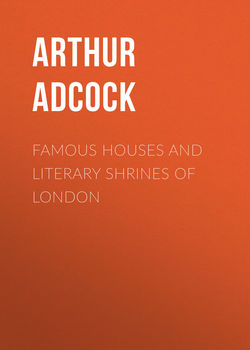Famous Houses and Literary Shrines of London

Реклама. ООО «ЛитРес», ИНН: 7719571260.
Оглавление
Adcock Arthur St. John. Famous Houses and Literary Shrines of London
CHAPTER I. SOME CELEBRATED COCKNEYS
CHAPTER II. SHAKESPEARE IN LONDON
CHAPTER III. WHERE POPE STAYED AT BATTERSEA
CHAPTER IV. HOGARTH
CHAPTER V. GOLDSMITH, REYNOLDS, AND SOME OF THEIR CIRCLE
CHAPTER VI. HOMES AND HAUNTS OF JOHNSON AND BOSWELL
CHAPTER VII. BLAKE AND FLAXMAN
CHAPTER VIII. A HAMPSTEAD GROUP
CHAPTER IX. ROUND ABOUT SOHO AGAIN
CHAPTER X. A PHILOSOPHER, TWO POETS, AND A NOVELIST
CHAPTER XI. CHARLES LAMB
CHAPTER XII. ST. JOHN’S WOOD AND WIMBLEDON
CHAPTER XIII. CHELSEA MEMORIES
CHAPTER XIV. THACKERAY
CHAPTER XV. DICKENS
CHAPTER XVI. CONCLUSION
Отрывок из книги
Until quite recently none of us knew of any address in London that had ever been Shakespeare’s; we knew of no house, of no street even, which had once numbered him among its tenants, though we know that he passed at least twenty of the busiest and most momentous years of his life in the metropolis. There is a plausible but vague tradition that during some part of that period he had lodgings in Southwark near the Globe Theatre, in which he acted, for which he wrote plays, and of which he was one of the proprietors. There used to be an inscription: “Here lived William Shakespeare,” on the face of an old gabled house in Aldersgate Street, but there was never a rag of evidence to support the statement. We have no letters of Shakespeare, but we have one or two that refer to him, and one written to him by Richard Quiney, and I think we may infer from this latter that Shakespeare occasionally visited Quiney, who was a vintner, dwelling at the sign of the Bell in Carter Lane. Otherwise, except for a handful of small-beer chronicles about him that were picked up in theatrical circles two or three generations after his death, we had no record of any incident in his London life that brought us into actual personal touch with him until little more than two years ago. Then an American professor, Mr. Charles William Wallace, came over and did what our English students do not appear to have had the energy or enterprise to do for themselves – he toiled carefully through the dusty piles of documents preserved in the Record Office, and succeeded in unearthing one of the most interesting Shakespearean discoveries that have ever been made – a discovery that gives us vividly intimate glimpses of Shakespeare’s life in London, and establishes beyond question his place of residence here in the years when he was writing some of the greatest of his dramas.
In 1587 the company of the “Queen’s Players” made their first appearance in Stratford-on-Avon, and it was about this date, so far as can be traced, that Shakespeare ran away from home; so you may reasonably play with a fancy that he joined this company in some very minor capacity and travelled with them to London. At this time, Burbage, who was by profession an actor and by trade a carpenter and joiner, was owner and manager of “The Theatre,” which stood in Shoreditch near the site of the present Standard Theatre, and close by was a rival house, “The Curtain” (commemorated nowadays by Curtain Road); and according to the legend, which has developed into a legend of exact detail, yet rests on nothing but the airiest rumour, it was outside one or both of these theatres Shakespeare picked up a living on his arrival in London by minding horses whilst their owners were inside witnessing a performance.
.....
St. Saviour’s, then, the sites of the Globe Theatre and the Mermaid, and that corner of Monkwell Street are London’s chief Shakespearean shrines. The discovery of the Monkwell Street residence emphasises that before Ben Jonson founded his Apollo Club at the Devil Tavern by Temple Bar, Cheapside and not Fleet Street was the heart of literary London. Whilst Shakespeare made his home with the Mountjoys, Ben Jonson and Dekker were living near him in Cripplegate, in which district also resided Johnson the actor, Anthony Munday, and other of Shakespeare’s intimates; nearer still, in Aldermanbury, lived Heminges and Condell, his brother actors, who first collected and published his plays after his death: and George Wilkins, at whose inn near St. Sepulchre’s Stephen Bellott and his wife lodged after their quarrel with Mountjoy, was a minor dramatist who, besides collaborating with Rowley, collaborated with Shakespeare himself in the writing of Pericles. Coryat, the eccentric author of the Crudities, lived in Bow Lane; Donne, who was born in Wood Street, wrote his early poems there in the house of the good merchant, his father, and was a frequenter of the Mermaid.
In 1608 Milton was born in Bread Street (Shakespeare must have passed his door many a time in his goings to and fro), and grew up to live and work within the City walls in Aldersgate Street, and in Bartholomew Close, and just without them in Bunhill Row, and was brought back within them to be buried in Cripplegate Church. These, and its earlier and many later literary associations, help to halo Cheapside and its environs, and, in spite of the sordid commercial aspect and history that have overtaken it, to make it for ever a street in the kingdom of romance.
.....